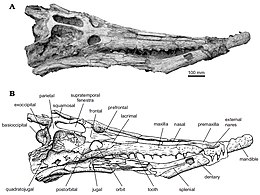| Dyrosauridae | |
|---|---|

| |
| Skull of the dyrosaurid Arambourgisuchus khouribgaensis | |
| Scientific classification | |
| Domain: | Eukaryota |
| Kingdom: | Animalia |
| Phylum: | Chordata |
| Class: | Reptilia |
| Clade: | Archosauria |
| Clade: | Pseudosuchia |
| Clade: | Crocodylomorpha |
| Clade: | Crocodyliformes |
| Suborder: | †Tethysuchia |
| Family: | †Dyrosauridae de Stefano, 1903 |
| Genera | |
| |
Dyrosauridae is a family of extinct neosuchian crocodyliforms that lived from the Campanian to the Eocene. Dyrosaurid fossils are globally distributed, having been found in Africa, Asia, Europe, North America and South America. Over a dozen species are currently known, varying greatly in overall size and cranial shape. A majority were aquatic, some terrestrial and others fully marine (see locomotion below), with species inhabiting both freshwater and marine environments. Ocean-dwelling dyrosaurids were among the few marine reptiles to survive the Cretaceous–Paleogene extinction event.
The dyrosaurids were a group of mostly marine, long jawed, crocodile-like quadrupeds up to 6 metres (20 ft) long.[1] The largest dyrosaurid was probably Phosphatosaurus estimated at 9 m (30 ft) in length.[2][3] Based on bone tissue evidence, it has been hypothesized that they were slow-growing[4] near-shore marine animals with interlocking closed jaws,[4] able to swim as well as walk on land. External nostrils at the posterior end of its snout and an internal naris in its pterygoid indicated a habit of hunting while swimming with the top of the head above the water, enabling it to breathe while stalking prey.[1]
- ^ a b Jouve, Stéphane (March 2005). "A new description of the skull of Dyrosaurus phosphaticus (Thomas, 1893) (Mesoeucrocodylia: Dyrosauridae) from the Lower Eocene of North Africa". Canadian Journal of Earth Sciences. 42 (3): 323–337. Bibcode:2005CaJES..42..323J. doi:10.1139/e05-008. ISSN 0008-4077. Retrieved March 22, 2021.
- ^ Buffetaut, E. (1978). "Les Dyrosauridae (Crocodylia, Mesosuchia) des phosphates de l'Eocène inférieur de Tunisie: Dyrosaurus, Rhabdognathus, Phosphatosaurus". Géologie Méditerranéenne. 5 (2): 237–256. doi:10.3406/geolm.1978.1046.
- ^ Martin, Jeremy E.; Antoine, Pierre-Olivier; Perrier, Vincent; Welcomme, Jean-Loup; Metais, Gregoire; Marivaux, Laurent (2019-07-04). "A large crocodyloid from the Oligocene of the Bugti Hills, Pakistan" (PDF). Journal of Vertebrate Paleontology. 39 (4): e1671427. Bibcode:2019JVPal..39E1427M. doi:10.1080/02724634.2019.1671427. ISSN 0272-4634. S2CID 209439989.
- ^ a b Cite error: The named reference
andradewas invoked but never defined (see the help page).